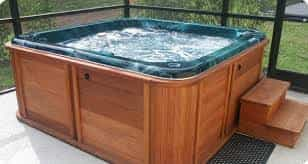Running a commercial or public aquatic facility with a spa poses unique challenges to managers and maintenance personnel. Many people experience little trouble operating a pool, but feel that a spa causes a persistent headache. Fortunately the answer to eliminate much of the hassle inherent with spas is very simple. The solution mainly involves draining the spa and refilling it with fresh water. The need to drain a spa on a regular basis results from spa’s higher water temperatures, and smaller volumes of water compared to swimming pools.
The higher water temperatures in spa water cause:
Faster chemical reactions.
Increased evaporation rates
More organic waste in the water
Accelerated bacteria growth
Chemical reactions occur more quickly in a spa environment. Pools normally operate between 76 to 86 degrees fahrenheit. Spas typically have water temperatures of 96 to 104 degrees. For every 18-degree rise in temperature, chemical reactions occur twice as fast. For example, a chemical reaction in spa water at 102 degrees fahrenheit will occur twice as fast than in a pool with water kept at 84 degrees.
In addition to faster chemical reactions the water in a spa evaporates at higher rate. The faster evaporation of spa water results from high water temperature, rapid water circulation, and aeration. As the water evaporates it leaves behind dissolved solids in the spa water. When the level of total dissolved solids rises the spa water will become increasingly cloudy.
Along with cloudy water, spas that are not regularly drained also tend to have more organic wastes in the water. The hot water in a spa causes users to sweat. An average spa user sweets a pint in just 20 minutes while using a spa. In addition to sweat, dirt, and dead skin enter the water from the scrubbing action of spa therapy jets. As a result spa filtration and chemical feed system process a higher percentage of waste compared to a pool.
If not cared for properly a spa will become the ideal incubator for bacteria. Hot water provides an ideal environment for the growth of most strains of bacteria.
Smaller volumes of water result in:
Heavier bather loads
The need for precise chemical dosing
More abrupt changes in pH and sanitizer levels
The smaller size of a spa means a higher concentration of people per gallon of water. A normal size spa will have 100 to 400 gallons of water for one person. Pools tend to have at least 10 times this amount of water per swimmer. For instance, two people in a 400 gallon spa is roughly the equivalent bather load of 150 swimmers in a 30,000 gallon pool.
This heavier bather load combined with the faster chemical reactions in hot water can lower a spa’s sanitizer level rapidly. To maintain proper levels, spas require very precise chemical dosing. A small error in the amount of chemical added can result in many water balance problems. Since a spa has a small water volume, small additions of sanitizers and other chemicals will have an immediate effect on the water’s pH. To prevent improper levels and equipment damage, the sanitizer, pH, and alkalinity levels should be monitored frequently. Proper dosing should be performed to keep all three of these factors at the right balance. Remember that as the water evaporates dissolved solids will remain in the water from the products used to adjust the chemical levels.
The organic waste and high levels of dissolved solids will cause problems if someone fails to address these issues. Adding the proper amount of chemicals and relying on the filtration system will work to a certain point. Eventually the amount of organic wastes and total dissolved solids will rise to a level that chemical dosing and filtration will not adequately maintain the water to accepted standards. This is where the headaches begin. At this point its time to drain the spa and refill it with fresh water. To prevent headaches all together, Allegheny Pool Services Co. recommends that you use the industry standard formula to schedule draining your spa.
Spa Gallons ÷ 3 ÷ Average Number of Daily Users = Number of Days Between Drainings
For example, in a 600 gallon spa with an average daily user load of 4 people, the formula would work as follows:
600 Gallons ÷ 3 ÷ 4 Users = 50 Days
According to the equation, the spa in this example should be drained and refilled every 50 days. Draining and refilling the spa in the example every 50 days will help prevent the problems inherent with high water temperatures and small volumes of water.
I hope you found this discussion on spas helpful. We are here to assist you with providing your patrons the best swimming experience possible. If you have any questions regarding the topics in this explanation or would like to discuss any other pool or spa issues please contact us. You can also find more information at our homepage.
Thanks for Reading,
Tim Johnson

